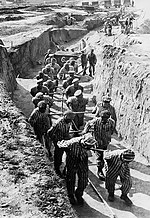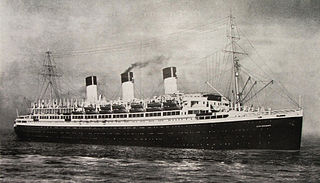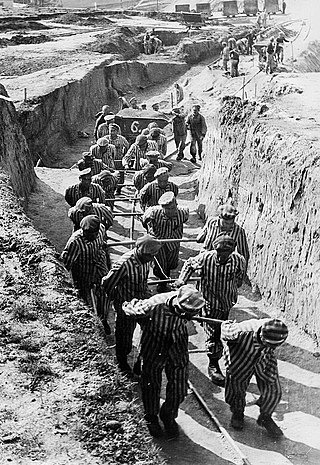| Nazi concentration camps | ||||
|---|---|---|---|---|
 | ||||
| Main camps | ||||
Organization
| ||||
| Topics | ||||
| Personnel | ||||
Prisoners
|
Arbeitsdorf ("work-village") was a Nazi concentration camp in Stadt des KdF-Wagens bei Fallersleben 1942.
| Nazi concentration camps | ||||
|---|---|---|---|---|
 | ||||
| Main camps | ||||
Organization
| ||||
| Topics | ||||
| Personnel | ||||
Prisoners
|
Arbeitsdorf ("work-village") was a Nazi concentration camp in Stadt des KdF-Wagens bei Fallersleben 1942.
In 1936, a Czech engineer by the name of Ferdinand Porsche designed a prototype of a car that would be affordable enough for all Germans to buy. He then showed his idea to the then dictator of Germany, Adolf Hitler. Hitler liked his idea and ordered the manufacture of the car which was known as the KDF-Wagen or later known as the Volkswagen vehicle.
With Hitler's approval, Porsche and his business partner Albert Speer set up a factory in Fallersleben, a town 30 miles (48 kilometres) northeast of the city of Braunschweig, and because of the war, all production from this camp was to be used for military purposes only. In 1939 the Nazi looked for inmates to put in the camp. In 1942, Porsche and Speer started a project to see how they could use concentration camp inmates for cheaper, and large-scale production of their cars, in order to benefit their industry. The prisoners of Arbeitsdorf were skilled workforce used for construction tasks, building a casting plant and other facilities and receiving better captivity conditions in return.
So on 8 April 1942 a new concentration camp, Arbeitsdorf, was opened with 800 inmates from the Neuengamme concentration camp. The camp commands of Neuengamme and Arbeitsdorf were united in the person of Martin Weiss, the camp commander of Neuengamme at this time. On 26 April 1942 inmates from the Sachsenhausen concentration camp and on 23 June inmates from Buchenwald arrived. Mid-July 1942 camp commander became Wilhelm Schitli, former Schutzhaft-camp commander in Neuengamme. [1]
On 11 October 1942, six months after the camp was first established, production of the vehicles was stopped and the camp was closed. A minimum of six prisoners perished at Arbeitsdorf. These six deaths are officially listed as suicide, heart attack or accident. [1]
The museum Stadtschloss Wolfsburg has a documentation about the Nazi victims with its own exhibition of the slave workers at the Volkswagen factory. (Stadtmuseum Schloss Wolfsburg, Schlossstraße 8, 38448 Wolfsburg)

Berthold Konrad Hermann Albert Speer was a German architect who served as the Minister of Armaments and War Production in Nazi Germany during most of World War II. A close ally of Adolf Hitler, he was convicted at the Nuremberg trial and sentenced to 20 years in prison.

Ferdinand Porsche was an Austro-Bohemian automotive engineer and founder of the Porsche AG. He is best known for creating the first gasoline–electric hybrid vehicle (Lohner–Porsche), the Volkswagen Beetle, the Auto Union racing car, the Mercedes-Benz SS/SSK, several other important developments and Porsche automobiles.

Wolfsburg is the fifth largest city in the German state of Lower Saxony, located on the river Aller. It lies about 75 km (47 mi) east of Hanover and 230 km (143 mi) west of Berlin.

SS Cap Arcona, named after Cape Arkona on the island of Rügen, was a large German ocean liner, later a ship of the German Navy, and finally a prison ship. A flagship of the Hamburg Südamerikanische Dampfschifffahrts-Gesellschaft, she made her maiden voyage on 29 October 1927, carrying passengers and cargo between Germany and the east coast of South America, and in her time was the largest and quickest ship on the route.


Oswald Ludwig Pohl was a German SS functionary during the Nazi era. As the head of the SS Main Economic and Administrative Office and the head administrator of the Nazi concentration camps, he was a key figure in the Final Solution, the genocide of the European Jews. After the war, Pohl went into hiding; he was apprehended in 1946. Pohl stood trial in 1947, was convicted of crimes against humanity, and sentenced to death. After repeatedly appealing his case, he was executed by hanging in 1951.

Stutthof was a Nazi concentration camp established by Nazi Germany in a secluded, marshy, and wooded area near the village of Stutthof 34 km (21 mi) east of the city of Danzig (Gdańsk) in the territory of the German-annexed Free City of Danzig. The camp was set up around existing structures after the invasion of Poland in World War II and initially used for the imprisonment of Polish leaders and intelligentsia. The actual barracks were built the following year by prisoners. Most of the infrastructure of the concentration camp was either destroyed or dismantled shortly after the war. In 1962, the former concentration camp with its remaining structures, was turned into a memorial museum.

Mittelbau-Dora was a Nazi concentration camp located five miles from the town center of Nordhausen in Thuringia, Germany. It was established in late summer 1943 as a subcamp of Buchenwald concentration camp, supplying slave labour from many Eastern countries occupied by Germany, for extending the nearby tunnels in the Kohnstein and for manufacturing the V-2 rocket and the V-1 flying bomb. In the summer of 1944, Mittelbau became an independent concentration camp with numerous subcamps of its own. In 1945, most of the surviving inmates were sent on death marches or crammed in trains of box-cars by the SS. On 11 April 1945, US troops freed the remaining prisoners.

From 1933 to 1945, Nazi Germany operated more than a thousand concentration camps, including subcamps on its own territory and in parts of German-occupied Europe.

The SS Main Economic and Administrative Office was a Nazi organization responsible for managing the finances, supply systems and business projects of the Allgemeine-SS. It also ran the concentration camps and was instrumental in the implementation of the Final Solution through such subsidiary offices as the Concentration Camps Inspectorate and SS camp guards.

Holocaust victims were people targeted by the government of Nazi Germany based on their ethnicity, religion, political beliefs, and/or sexual orientation. The institutionalized practice by the Nazis of singling out and persecuting people resulted in the Holocaust, which began with legalized social discrimination against specific groups, involuntary hospitalization, euthanasia, and forced sterilization of persons considered physically or mentally unfit for society. The vast majority of the Nazi regime's victims were Jews, Sinti-Roma peoples, and Slavs but victims also encompassed people identified as social outsiders in the Nazi worldview, such as homosexuals, and political enemies. Nazi persecution escalated during World War II and included: non-judicial incarceration, confiscation of property, forced labor, sexual slavery, death through overwork, human experimentation, undernourishment, and execution through a variety of methods. For specified groups like the Jews, genocide was the Nazis' primary goal.

The Tatra 97 (T97) is a Czechoslovak mid-size car built by Tatra in Kopřivnice, Moravia from 1936 to 1939.

Wöbbelin was a subcamp of the Neuengamme concentration camp near the city of Ludwigslust. The SS had established Wöbbelin to house concentration camp prisoners whom the SS had evacuated from other camps to prevent their liberation by the Allies. At its height, Wöbbelin held some 5,000 inmates, most of whom were suffering from starvation and disease. The camp was freed on May 2, 1945.

Dessauer Ufer was a subcamp of the Neuengamme concentration camp in Nazi Germany, located inside the Port of Hamburg on the Kleiner Grasbrook in Veddel. It was in operation from July 1944 to April 1945. Inmates were mostly used for forced labour at rubble clearing and building in the Hamburg port area.
Alfred Trzebinski was an SS-physician at the Auschwitz, Majdanek and Neuengamme concentration camps in Nazi Germany. He was sentenced to death and executed for his involvement in war crimes committed at the Neuengamme subcamps.
Anton Piëch was an Austrian-German lawyer and the son-in-law of Ferdinand Porsche. He headed Volkswagenwerk GmbH between 1941 and 1945, which produced the Volkswagen vehicles (KdF-Wagen) at the factory in Wolfsburg, Germany.
The SS-Baubrigaden were a type of subcamp of Nazi concentration camps that were first established in Autumn 1942. These units were usually made up of male non-Jewish prisoners—most were Poles or Soviets. Chances of survival were higher in these mobile units than the main camps they were attached to. The deployment of the Baubrigaden to major cities within the German Reich was the first time the German public became aware of the living conditions in concentration camps.

Forced labor was an important and ubiquitous aspect of the Nazi concentration camps which operated in Nazi Germany and German-occupied Europe between 1933 and 1945. It was the harshest and most inhumane part of a larger system of forced labor in Nazi Germany.